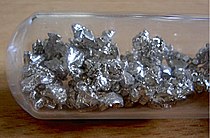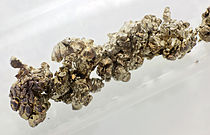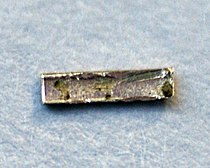
A | B | C | D | E | F | G | H | CH | I | J | K | L | M | N | O | P | Q | R | S | T | U | V | W | X | Y | Z | 0 | 1 | 2 | 3 | 4 | 5 | 6 | 7 | 8 | 9
| Alkaline earth metals | |||||||||||
|---|---|---|---|---|---|---|---|---|---|---|---|
| |||||||||||
| ↓ Period | |||||||||||
| 2 | Beryllium (Be) 4 | ||||||||||
| 3 | Magnesium (Mg) 12 | ||||||||||
| 4 | Calcium (Ca) 20 | ||||||||||
| 5 | Strontium (Sr) 38 | ||||||||||
| 6 | Barium (Ba) 56 | ||||||||||
| 7 | Radium (Ra) 88 | ||||||||||
|
Legend
| |||||||||||
The alkaline earth metals are six chemical elements in group 2 of the periodic table. They are beryllium (Be), magnesium (Mg), calcium (Ca), strontium (Sr), barium (Ba), and radium (Ra).[1] The elements have very similar properties: they are all shiny, silvery-white, somewhat reactive metals at standard temperature and pressure.[2]
Together with helium, these elements have in common an outer s orbital which is full—[2][3][4] that is, this orbital contains its full complement of two electrons, which the alkaline earth metals readily lose to form cations with charge +2, and an oxidation state of +2.[5] Helium is grouped with the noble gases and not with the alkaline earth metals, but it is theorized to have some similarities to beryllium when forced into bonding and has sometimes been suggested to belong to group 2.[6][7][8]
All the discovered alkaline earth metals occur in nature, although radium occurs only through the decay chain of uranium and thorium and not as a primordial element.[9] There have been experiments, all unsuccessful, to try to synthesize element 120, the next potential member of the group.
Characteristics
Chemical
As with other groups, the members of this family show patterns in their electronic configuration, especially the outermost shells, resulting in trends in chemical behavior:
| Z | Element | No. of electrons/shell | Electron configuration[n 1] |
|---|---|---|---|
| 4 | beryllium | 2, 2 | [He] 2s2 |
| 12 | magnesium | 2, 8, 2 | [Ne] 3s2 |
| 20 | calcium | 2, 8, 8, 2 | [Ar] 4s2 |
| 38 | strontium | 2, 8, 18, 8, 2 | [Kr] 5s2 |
| 56 | barium | 2, 8, 18, 18, 8, 2 | [Xe] 6s2 |
| 88 | radium | 2, 8, 18, 32, 18, 8, 2 | [Rn] 7s2 |
Most of the chemistry has been observed only for the first five members of the group. The chemistry of radium is not well-established due to its radioactivity;[2] thus, the presentation of its properties here is limited.
The alkaline earth metals are all silver-colored and soft, and have relatively low densities, melting points, and boiling points. In chemical terms, all of the alkaline earth metals react with the halogens to form the alkaline earth metal halides, all of which are ionic crystalline compounds (except for beryllium chloride, beryllium bromide and beryllium iodide, which are covalent). All the alkaline earth metals except beryllium also react with water to form strongly alkaline hydroxides and, thus, should be handled with great care. The heavier alkaline earth metals react more vigorously than the lighter ones.[2] The alkaline earth metals have the second-lowest first ionization energies in their respective periods of the periodic table[4] because of their somewhat low effective nuclear charges and the ability to attain a full outer shell configuration by losing just two electrons. The second ionization energy of all of the alkaline metals is also somewhat low.[2][4]
Beryllium is an exception: It does not react with water or steam unless at very high temperatures,[10] and its halides are covalent. If beryllium did form compounds with an ionization state of +2, it would polarize electron clouds that are near it very strongly and would cause extensive orbital overlap, since beryllium has a high charge density. All compounds that include beryllium have a covalent bond.[11] Even the compound beryllium fluoride, which is the most ionic beryllium compound, has a low melting point and a low electrical conductivity when melted.[12][13][14]
All the alkaline earth metals have two electrons in their valence shell, so the energetically preferred state of achieving a filled electron shell is to lose two electrons to form doubly charged positive ions.
Compounds and reactions
The alkaline earth metals all react with the halogens to form ionic halides, such as calcium chloride (CaCl
2), as well as reacting with oxygen to form oxides such as strontium oxide (SrO). Calcium, strontium, and barium react with water to produce hydrogen gas and their respective hydroxides (magnesium also reacts, but much more slowly), and also undergo transmetalation reactions to exchange ligands.
Solubility-related constants for alkaline-earth-metal fluorides Metal M2+ hydration (-MJ/mol) [15] "MF2" unit hydration (-MJ/mol)[16] MF2 lattice (-MJ/mol)[17] Solubility (mol/kL)[18] Be 2.455 3.371 3.526 soluble Mg 1.922 2.838 2.978 1.2 Ca 1.577 2.493 2.651 0.2 Sr 1.415 2.331 2.513 0.8 Ba 1.361 2.277 2.373 6
Physical and atomic
| Alkaline earth metal | Standard atomic weight (u)[n 2][20][21] |
Melting point (K) |
Melting point (°C) |
Boiling point (K)[4] |
Boiling point (°C)[4] |
Density (g/cm3) |
Electronegativity (Pauling) |
First ionization energy (kJ·mol−1) |
Covalent radius (pm)[22] |
Flame test color | |
|---|---|---|---|---|---|---|---|---|---|---|---|
| Beryllium | 9.012182(3) | 1560 | 1287 | 2744 | 2471 | 1.848 | 1.57 | 899.5 | 105 | White[23] | |
| Magnesium | 24.3050(6) | 923 | 650 | 1363 | 1090 | 1.738 | 1.31 | 737.7 | 150 | Brilliant-white[2] | |
| Calcium | 40.078(4) | 1115 | 842 | 1757 | 1484 | 1.54 | 1.00 | 589.8 | 180 | Brick-red[2] | |
| Strontium | 87.62(1) | 1050 | 777 | 1655 | 1382 | 2.64 | 0.95 | 549.5 | 200 | Crimson[2] | |
| Barium | 137.327(7) | 1000 | 727 | 2170 | 1897 | 3.62 | 0.89 | 502.9 | 215 | Apple-green[2] | |
| Radium | [n 3] | 969 | 696 | 2010 | 1737 | 5.5 | 0.9 | 509.3 | 221 | Crimson red[n 4] | |
Nuclear stability
Isotopes of all six alkaline earth metals are present in the Earth's crust and the solar system at varying concentrations, dependent upon the nuclides' half lives and, hence, their nuclear stabilities. The first five have one, three, five, four, and six stable (or observationally stable) isotopes respectively, for a total of 19 stable nuclides, as listed here: beryllium-9; magnesium-24, -25, -26; calcium-40, -42, -43, -44, -46; strontium-84, -86, -87, -88; barium-132, -134, -135, -136, -137, -138. The four underlined isotopes in the list are predicted by radionuclide decay energetics to be only observationally stable and to decay with extremely long half-lives through double-beta decay, though no decays attributed definitively to these isotopes have yet been observed as of 2024. Radium has no stable nor primordial isotopes.
In addition to the stable species, calcium and barium each have one extremely long-lived and primordial radionuclide: calcium-48 and barium-130, with half-lives of 5.6×1019 and 1.6×1021 years, respectively. Both are far longer than the current age of the universe (4.7× and 117× billion times longer, respectively) and less than one part per ten billion has decayed since the formation of the Earth. The two isotopes are stable for practical purposes.
Apart from the 21 stable or nearly-stable isotopes, the six alkaline earth elements each possess a large number of known radioisotopes. None of the isotopes other than the aforementioned 21 are primordial: all have half lives too short for even a single atom to have survived since the solar system's formation, after the seeding of heavy nuclei by nearby supernovae and collisions between neutron stars, and any present are derived from ongoing natural processes. Beryllium-7, beryllium-10, and calcium-41 are trace, as well as cosmogenic, nuclides, formed by the impact of cosmic rays with atmospheric or crustal atoms. The longest half-lives among them are 1.387 million years for beryllium-10, 99.4 thousand years for calcium-41, 1599 years for radium-226 (radium's longest-lived isotope), 28.90 years for strontium-90, 10.51 years for barium-133, and 5.75 years for radium-228. All others have half-lives of less than half a year, most significantly shorter.
Calcium-48 and barium-130, the two primordial and non-stable isotopes, decay only through double beta emission and have extremely long half-lives, by virtue of the extremely low probability of both beta decays occurring at the same time. All isotopes of radium are highly radioactive and are primarily generated through the decay of heavier radionuclides. The longest-lived of them is radium-226, a member of the decay chain of uranium-238.[25] Strontium-90 and barium-140 are common fission products of uranium in nuclear reactors, accounting for 5.73% and 6.31% of uranium-235's fission products respectively when bombarded by thermal neutrons.[26] The two isotopes have half-lives each of 28.90 years and 12.7 days. Strontium-90 is produced in appreciable quantities in operating nuclear reactors running on uranium-235 or plutonium-239 fuel, and a minuscule secular equilibrium concentration is also present due to rare spontaneous fission decays in naturally occurring uranium.
Calcium-48 is the lightest nuclide to undergo double beta decay, as it is a nuclide with both even proton and neutron numbers and subsequently energetically forbidden to undergo single beta decays.[27] Naturally occurring calcium and barium are very weakly radioactive: calcium contains about 0.1874% calcium-48,[28] and barium contains about 0.1062% barium-130.[29] On average, one double-beta decay of calcium-48 will occur per second for every 90 tons of natural calcium, or 230 tons of limestone (calcium carbonate).[30] Through the same decay mechanism, one decay of barium-130 will occur per second for every 16,000 tons of natural barium, or 27,000 tons of baryte (barium sulfate).[31]
The longest lived isotope of radium is radium-226 with a half-life of 1600 years; it along with radium-223, -224, and -228 occur naturally in the decay chains of primordial thorium and uranium. Beryllium-8 is notable by its absence as it splits in half virtually instantaneously into two alpha particles whenever it is formed. The triple alpha process in stars can only occur at energies high enough for beryllium-8 to fuse with a third alpha particle before it can decay, forming carbon-12. This thermonuclear rate-limiting bottleneck is the reason most main sequence stars spend billions of years fusing hydrogen within their cores, and only rarely manage to fuse carbon before collapsing into a stellar remnant, and even then merely for a timescale of ~1000 years.[32] The radioisotopes of alkaline earth metals tend to be "bone seekers" as they behave chemically similar to calcium, an integral component of hydroxyapatite in compact bone, and gradually accumulate in the human skeleton. The incorporated radionuclides inflict significant damage to the bone marrow over time through the emission of ionizing radiation, primarily alpha particles. This property is made use of in a positive manner in the radiotherapy of certain bone cancers, since the radionuclides' chemical properties causes them to preferentially target cancerous growths in bone matter, leaving the rest of the body relatively unharmed.
Compared to their neighbors in the periodic table, alkaline earth metals tend to have a larger number of stable isotopes as they all possess an even number of protons, owing to their status as period 2 elements. Their isotopes are generally more stable due to nucleon pairing. This stability is further enhanced if the isotope also has an even number of neutrons, as both kinds of nucleons can then participate in pairing and contribute to nuclei stability.
History
Etymology
The alkaline earth metals are named after their oxides, the alkaline earths, whose old-fashioned names were beryllia, magnesia, lime, strontia, and baria. These oxides are basic (alkaline) when combined with water. "Earth" was a term applied by early chemists to nonmetallic substances that are insoluble in water and resistant to heating—properties shared by these oxides. The realization that these earths were not elements but compounds is attributed to the chemist Antoine Lavoisier. In his Traité Élémentaire de Chimie (Elements of Chemistry) of 1789 he called them salt-forming earth elements. Later, he suggested that the alkaline earths might be metal oxides, but admitted that this was mere conjecture. In 1808, acting on Lavoisier's idea, Humphry Davy became the first to obtain samples of the metals by electrolysis of their molten earths,[33] thus supporting Lavoisier's hypothesis and causing the group to be named the alkaline earth metals.
Discovery
The calcium compounds calcite and lime have been known and used since prehistoric times.[34] The same is true for the beryllium compounds beryl and emerald.[35] The other compounds of the alkaline earth metals were discovered starting in the early 15th century. The magnesium compound magnesium sulfate was first discovered in 1618 by a farmer at Epsom in England. Strontium carbonate was discovered in minerals in the Scottish village of Strontian in 1790. The last element is the least abundant: radioactive radium, which was extracted from uraninite in 1898.[36][37][38]
All elements except beryllium were isolated by electrolysis of molten compounds. Magnesium, calcium, and strontium were first produced by Humphry Davy in 1808, whereas beryllium was independently isolated by Friedrich Wöhler and Antoine Bussy in 1828 by reacting beryllium compounds with potassium. In 1910, radium was isolated as a pure metal by Curie and André-Louis Debierne also by electrolysis.[36][37][38]
Beryllium

Beryl, a mineral that contains beryllium, has been known since the time of the Ptolemaic Kingdom in Egypt.[35] Although it was originally thought that beryl was an aluminum silicate,[39] beryl was later found to contain a then-unknown element when, in 1797, Louis-Nicolas Vauquelin dissolved aluminum hydroxide from beryl in an alkali.[40] In 1828, Friedrich Wöhler[41] and Antoine Bussy[42] independently isolated this new element, beryllium, by the same method, which involved a reaction of beryllium chloride with metallic potassium; this reaction was not able to produce large ingots of beryllium.[43] It was not until 1898, when Paul Lebeau performed an electrolysis of a mixture of beryllium fluoride and sodium fluoride, that large pure samples of beryllium were produced.[43]
Magnesium
Magnesium was first produced by Humphry Davy in England in 1808 using electrolysis of a mixture of magnesia and mercuric oxide.[44] Antoine Bussy prepared it in coherent form in 1831. Davy's first suggestion for a name was magnium,[44] but the name magnesium is now used.
Calcium
Lime has been used as a material for building since 7000 to 14,000 BCE,[34] and kilns used for lime have been dated to 2,500 BCE in Khafaja, Mesopotamia.[45][46] Calcium as a material has been known since at least the first century, as the ancient Romans were known to have used calcium oxide by preparing it from lime. Calcium sulfate has been known to be able to set broken bones since the tenth century. Calcium itself, however, was not isolated until 1808, when Humphry Davy, in England, used electrolysis on a mixture of lime and mercuric oxide,[47] after hearing that Jöns Jakob Berzelius had prepared a calcium amalgam from the electrolysis of lime in mercury.
Strontium
In 1790, physician Adair Crawford discovered ores with distinctive properties, which were named strontites in 1793 by Thomas Charles Hope, a chemistry professor at the University of Glasgow,[48] who confirmed Crawford's discovery. Strontium was eventually isolated in 1808 by Humphry Davy by electrolysis of a mixture of strontium chloride and mercuric oxide. The discovery was announced by Davy on 30 June 1808 at a lecture to the Royal Society.[49]
Barium

Barite, a mineral containing barium, was first recognized as containing a new element in 1774 by Carl Scheele, although he was able to isolate only barium oxide. Barium oxide was isolated again two years later by Johan Gottlieb Gahn. Later in the 18th century, William Withering noticed a heavy mineral in the Cumberland lead mines, which are now known to contain barium. Barium itself was finally isolated in 1808 when Humphry Davy used electrolysis with molten salts, and Davy named the element barium, after baryta. Later, Robert Bunsen and Augustus Matthiessen isolated pure barium by electrolysis of a mixture of barium chloride and ammonium chloride.[50][51]
Radium
While studying uraninite, on 21 December 1898, Marie and Pierre Curie discovered that, even after uranium had decayed, the material created was still radioactive. The material behaved somewhat similarly to barium compounds, although some properties, such as the color of the flame test and spectral lines, were much different. They announced the discovery of a new element on 26 December 1898 to the French Academy of Sciences.[52] Radium was named in 1899 from the word radius, meaning ray, as radium emitted power in the form of rays.[53]
Zdroj:https://en.wikipedia.org?pojem=Alkaline_earth_metalText je dostupný za podmienok Creative Commons Attribution/Share-Alike License 3.0 Unported; prípadne za ďalších podmienok. Podrobnejšie informácie nájdete na stránke Podmienky použitia.
Antropológia
Aplikované vedy
Bibliometria
Dejiny vedy
Encyklopédie
Filozofia vedy
Forenzné vedy
Humanitné vedy
Knižničná veda
Kryogenika
Kryptológia
Kulturológia
Literárna veda
Medzidisciplinárne oblasti
Metódy kvantitatívnej analýzy
Metavedy
Metodika
Text je dostupný za podmienok Creative
Commons Attribution/Share-Alike License 3.0 Unported; prípadne za ďalších
podmienok.
Podrobnejšie informácie nájdete na stránke Podmienky
použitia.
www.astronomia.sk | www.biologia.sk | www.botanika.sk | www.dejiny.sk | www.economy.sk | www.elektrotechnika.sk | www.estetika.sk | www.farmakologia.sk | www.filozofia.sk | Fyzika | www.futurologia.sk | www.genetika.sk | www.chemia.sk | www.lingvistika.sk | www.politologia.sk | www.psychologia.sk | www.sexuologia.sk | www.sociologia.sk | www.veda.sk I www.zoologia.sk






